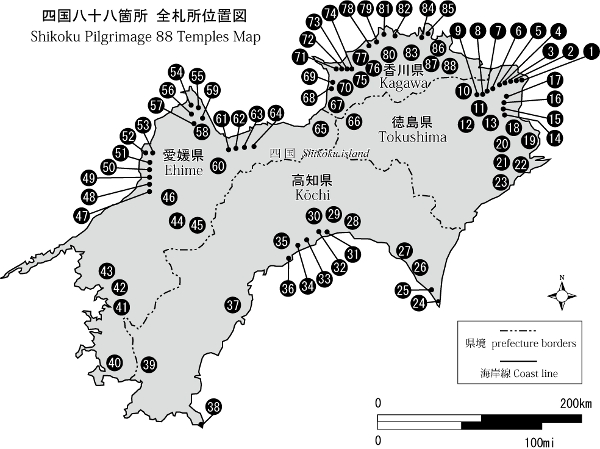Blog
From Santiago de Shikoku, the Way is circular
One of the leitmotifs of the Fairway congress –and, of course, of this blog– is promoting the universality of pilgrimages. It is no longer surprising that human communities repeated the same phenomenon down through the ages and in different territories. In one of the blog’s first posts we discussed the Kumano Kodo, a pilgrimage trail in Japan. This month we found out that the Way of St. James has “twinned” with the Shikoku O-Henro, another spiritual route in the Land of the Rising Sun. From the Far West to the Far East, the Way is circular.
Where is the Shikoku route and what does it consist of?
Shikoku is located in southwest Japan. It shares with the Way of St. James its religious aspect; however, in Japan, this phenomenon has a syncretic nature, i.e. it does not form part of a tradition arising from a fixed, unchangeable dogma, but incorporates and combines aspects of different religious traditions, such as Shintoism and Buddhism. The objective of the route is visiting the 88 temples of Shikoku. The total distance of the itinerary linking these sacred sites, associated with the great monk Kobo Daishi Kukai, is around 1,200 kilometres. According to tradition, Kukai lived 1,200 years ago and visited the temples while developing intellectually and spiritually. The Shikoku-Henro is the spiritual itinerary that this monk followed and which culminated with the founding of the Shingon Buddhist community.
The Shikoku tourist office estimates that close to half a million people follow this route. There is not an established itinerary, as in the case of the numerous roads to Santiago, but tradition dictates that a clockwise circular route should be followed. The route begins in the first sacred site of Ryozen-ji, in Tokushima prefecture, and continues clockwise as far as the 88th sacred site, the Okubo-ji temple, in Kagaw prefecture, which is the most famous of them all.
The Shikoku route’s period of maximum splendour was during the Edo society or Tokugawa Shogunate (a shogun was a military commander that occupied the second level of Japan’s social pyramid, just below the emperor), which lasted from the 17th century to beyond the mid-19th century. The samurais, the fourth social level that were subject to a lord, were not only privileged to handle weapons but also enjoyed solid intellectual training.
The Shikoku route was a unique trip for the Japanese of that time and, of course, it was not accessible to all social classes. Pilgrims started out from Edo (present-day Tokyo) on foot or by boat. Today, however, there are no longer rules regarding how the pilgrimage should be carried out. Unlike the Way of St. James, which only legitimises pilgrims that travel on foot, by bike, in a wheelchair or on horseback, many visitors follow the Shikoku route by bike, motorbike or car, or even using public transport. Neither are there any limitations regarding the pilgrims’ creed, nationality or age: it is a route open to everyone.

The towns and villages dotted along the route still have a traditional look, which contrasts with Japan’s megalopolis. The route is an oasis of peace where you can enjoy traditional Japanese cuisine, mild and balanced like few others. The twinning of both routes, one on either side of the globe, will bring an exchange of experiences and wealth for both of them. The governor of Kagawa expressed his desire that both Kumano Kodo and Shikoku Henro become a religious and cultural landmark similar to the Way of St. James, attracting as many visitors as the Jacobean route.
Would you like to complete one of these routes?